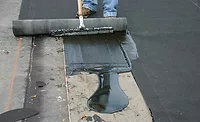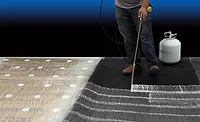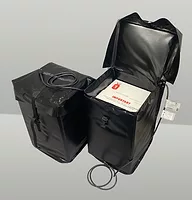The Use of Adhesives for Attachment in Roofing Applications

History of Adhesive Use in Roofing
The use of adhesives with roof systems is not new to the United States. In fact, the first built-up roof systems were actually an adhesive-based, cold-process system. In these early applications, pine tar was applied to glue the roofing fabrics together. In the early 1900s, during the height of the railroad expansion, solvent-based asphalt adhesives were sent on rail cars to remote areas for application of roofing felt with trowels and brushes. In later years, mineral-surfaced sheets were applied in medium viscosity asphalt mastics, which produced a roofing system that was capable of providing weatherproofing for a number of years.
In recent years, the market share of systems using adhesives as attachment methods have been minimal, typically less than 5 percent. However, there are a number of roofing and waterproofing manufacturers who have supplied adhesive attached systems in cold-process or cold-applied applications for the past 50 years. The longevity of these manufacturers indicates success with these attachment methods. Adhesives have also been used successfully with single-ply membranes in fully adhered systems since the ‘70s.
Adhesive Function in Roof Applications
The main function of the adhesive is to promote the adhesion or bonding of the reinforcement. A proper adhesive should not have an effect on the performance of the reinforcement. In this respect, it serves the same function as hot mopping or torch-applied on modified bitumen systems. On modified bitumen systems — SBS or APP — as with all single-ply membranes (EPDM, PVC, TPO, etc.), the sheets serve as the waterproofing component of the system. The attachment material is used only for fusion or adherence.In built-up roof systems the hot bitumen is the waterproofing agent and the felt is the stabilizer. In contrast, the adhesives used in cold-applied systems provide little waterproofing capacities and require either a waterproof base layer or a waterproof membrane. The basic difference of these materials is in their chemical properties. Asphalt is a thermoplastic material, which changes properties with an increase in temperature. The material turns to a liquid as the temperature increases. As the membrane is applied to the hot asphalt, the asphalt cools and solidifies and the curing process and subsequent waterproofing protection begins immediately. Total cure time is approximately two to three hours.
Adhesives contain solvents that must evaporate to provide a solid or cured state. The solvent evaporation process, or flashing as it is commonly refereed to, depends in a large degree to the rate of material application and ambient weather conditions over time. The system adhesion increases as the solvent evaporates. The most important aspect of a cold-applied system is that it must properly cure. Once adhesives cure there is no change in their properties. The bonding mechanism occurs as solvents evaporate and the adhesive dries to a thin film.
Solvent-based Adhesives
Adhesives for roof systems are classified in three categories: solvent-based, water-based and bonding adhesives. The most common are solvent-based adhesives. These products are generally asphalt cutbacks, which are manufactured by adding solvents, such as mineral spirits and varnishes, to asphalt that has been heated to 150 degrees F to 200 degrees F. The asphalt is heated to this temperature to make the asphalt fluid while maintaining enough heat to evaporate the solvents. Mastics and roof cements are manufactured by adding asphalt, solvents, and an organic filler such as cellotuse.
There are currently environmental concerns with the use of petroleum solvents in cold process adhesives. In some parts of the United States, regulations have been imposed on the use of volatile organic compounds. This has led to the reduction of solvent content in the adhesive, which can produce a material that is too thick to spread well. Solvent-based products can be applied over a wide range of temperatures including cold or marginal weather conditions. These adhesives cure quickly under conditions of high humidity.
Water-based Adhesives
The concerns regarding VOCs in solvent-based products have increased the use of water-based adhesives. The waterborne products are permanent roof materials, which are environmentally friendly because they do not contain solvents, organic or inorganic. Waterborne products use water and stabilizing clays other than petroleum or other distilled solvents.Asphalt emulsions are manufactured by dispersing very small droplets of asphalt bitumen in water. The manufacturing process is to mix the bitumen at a heated temperature at which it will become a free-flowing liquid (from 320 degrees F to 350 degrees F) with a mixture of water (at boiling point 180 F) and an emulsifying agent or clay such as bentonite. The elevated temperature of the water blends with the asphalt and the water cures.
The manufacturing process of modified bitumen adhesive (SEBS) is similar to the emulsion process except polymers, such as rubber, are added to the asphalt. The modified asphalt blend is mixed with the water and clay stabilizers. Waterborne products cure with heat; the greater the heat the quicker the cure time. In contrast to solvent-based products, humidity slows down the curing process.
Successful cold-process adhesives, both solvent-based and water-based, require a good asphalt bitumen blend to manufacture a good product, providing that the manufacturer also adds a good polymer. The asphalt used is refinery crude oil asphalt that has multiple blends of materials. The adhesive manufacturer can control the type of asphalt obtained from the refinery by specifying the properties desired in the crude oils and blend asphalts.
The important physical properties are softening point, penetration and ductility. Higher penetration asphalts and modified asphalts are softer than low penetration asphalts. Asphalt testing can be completed by conducting ASTM D-36: The Ring and Ball Test.
Bonding Adhesives
Bonding adhesives are used in the majority of single-ply membrane applications. They are used for the attachment of the membrane to approved insulation and substrates. Most bonding adhesives are manufactured with a neoprene base with added solvents such as toluene, hexane, acetone and other mineral spirits. In response to recent VOC regulations, some of the manufacturers have begun to provide water-based bonding adhesives. These types of adhesives use a latex/neoprene blend with no solvent additives.
Application procedures for all bonding adhesives are consistent with other adhesive applications. The substrate must be clean and free of all moisture and contaminants. The adhesives must be properly stirred, applied in an even uniform manner and flashed until they are tacky to the touch prior to membrane application. Also of critical importance is material storage and application temperatures. Adhesives have a typical shelf life of up to one year if the material is stored in the original sealed containers at approved temperatures. If the material is exposed to temperatures below regulated temperatures, the shelf life declines. The material must be stored in heated areas prior to application in cold temperatures.
Advantages
Adhesive bonding presents several distinct advantages over other conventional methods of attachment. First of all, very little equipment is required in the application of adhesives. Most of the work can be done with squeegees, trowels and brooms. Many of the cold adhesives can be applied with spraying equipment, which further reduces labor costs and simplifies the installation process. Often a crew of three to four workers is all that is required. The increased rate of application can be attributed to ease of application and the fact that there is no significant down time. Application rates increase with a reduction in setup time, equipment takedown time, equipment malfunctions and idle time (such as waiting for proper material heating with BUR systems).
As with all roofing and waterproofing systems, the success of the system is based in a large extent on proper application methods. The relative ease of application with these systems promotes quick and efficient worker training. Although these materials can be improperly applied, they do not rely on workmanship as much as BUR systems. There is no underheating or overheating of the materials and the materials tend to be forgiving of inaccuracies. Because of the curing process (which can be time consuming depending on weather), improperly applied sheets can be adjusted by the applicator during the installation process. This can reduce the cost of maintenance and repair, often required in correcting initial application processes. In contrast, the curing time and the sensitivity of the materials could be burdensome in colder climates.
Disadvantages
Some disadvantages may make adhesive bonding impractical in some roofing applications. Ironically, one the advantages of adhesives may also be a disadvantage. The relative ease of application and the resulting labor savings have initiated a growing trend of use by inexperienced applicators. In some instances, building owners, in an effort to save costs, have assembled their maintenance personnel to apply these materials. More often than not, these applications fail due to lack of proper training and supervision.Constraints imposed by weather conditions are another concern. Although all roofing and waterproofing systems have weather restrictions, these materials present a particular challenge. The applicator must have knowledge of the weather limitations of the materials and the allotted curing time. The materials cannot applied when there is a chance of precipitation or inclement weather. Some adhesives and coatings may wash away if they encounter precipitation prior to proper cure. Temperature restrictions may also prohibit the applicator from working on a day that other systems can be applied.
Although these materials are relatively easy to install, the proper installation procedures must be followed for successful application. Some of the more common application errors include:
- Entrapment of moisture in the insulation or membrane
- Inadequate or excessive use of adhesives
- Failure to properly set reinforcement sheets in the adhesive
- Improper preparation of the substrate or insulation
- Application of materials in unsuitable weather conditions
In spite of the challenges, the use of adhesives as attachment in roofing applications is growing. Some adhesives have Factory Mutual Wind Uplift ratings over certain types of substrates. Attachment over metal decks must always be completed with mechanical attachment. However, most cover board applications are approved with adhesive.
Looking for a reprint of this article?
From high-res PDFs to custom plaques, order your copy today!








